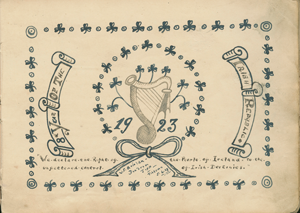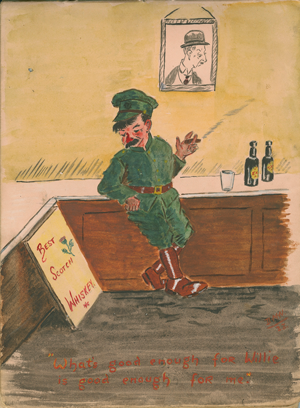JACK COMER’S TINTOWN AUTOGRAPH BOOK
Published in Artefacts, Issue 3 (May/June 2023), Volume 31By Úna Kavanagh
Autograph books were usually approximately the size of a Penguin paperback, with blank pages used to collect and exchange autographs and short written personal contributions. Like a predecessor of social media, they were often used by groups who shared a bond and wanted to preserve a keepsake of their inter-relationships. Contributions could be personal messages, poems or drawings, usually dedicated to the owner of the book as a reminder of a shared experience, time and place. The images and contributions discussed here are from the autograph book of Dr Jack Comer (1897–1974) of County Galway from his time as an IRA prisoner in 1923 in the Civil War internment camp known as Tintown No. 2 at the Curragh, Co. Kildare.
Thomas Madigan said that ‘between the present and the past there exists no more intimate connection than an autograph. It is a living symbol of its author.’ Autograph books from Tintown are significant because they provide a very personal history of the internees, their relationships, how they viewed themselves and their captors, and their contributions towards boosting each other’s morale and reaffirming their commonly held political ideologies, often omitting the harsh realities of life in a time and place of adversity and shared suffering.
The first image, ‘8th Year of the Irish Republic’, shows a harp, an iconic symbol of Ireland, centrally placed and surrounded by shamrocks, which draw further attention to its significance. A symbol of Irishness themselves, shamrocks are also used to frame the entire piece, merging the ideals of republicanism and Ireland. The banner—‘8th Year of The Irish Republic’—enhances the theme of Ireland as a republic since 1916. The contributor makes it very clear that the message being delivered here is the wish for Ireland to be seen as an independent, unencumbered, republic. Message and image combine to make it an unmistakable political statement.
The second image shows a soldier in National Army uniform. The artist has assigned him certain attributes that are intended to question his ability to perform his duties. His posture is relaxed, indicating that he is not standing to attention or on alert. His caricatured red nose and cheeks and the advertising placard for ‘Best Scotch Whiskey’ all imply habitual overindulgence in alcohol, while the two bottles of beer further imply that he has been drinking on duty. These elements combine with the quote at the bottom: ‘What’s good enough for Willie is good enough for me’, referring to W.T. Cosgrave, the pro-Treaty government leader, and a portrait of Cosgrave in a bowler hat hangs on the wall above the soldier. The artist’s implication that it is Scotch rather than Irish whiskey that Cosgrave drinks is a further sideswipe, indicating a preference for imported British spirits over local produce and employment. The bowler hat worn by Cosgrave introduces a colonial dimension to the piece, perhaps echoing James Connolly’s ‘old wine in new bottles’ characterisation of the anticipated (but never delivered) Home Rule government of 1914.
Comer’s autograph book is part of a fabric of supporting historical information that provides social context and deeper understanding to complement our documented history of the Irish Civil War.
Úna Kavanagh is completing a Ph.D at the Centre for Irish Studies, University of Galway, researching the Clonbrock Photographic Collection.


















